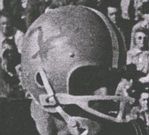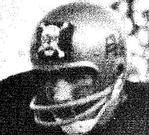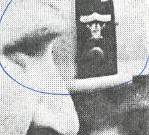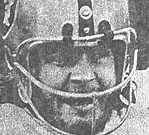|
|
|
Dear Dr. Del:
We were having a discussion during a recent game about our all time favorite helmet designs. It would be great if you shared your favorite with us.
Thanks,
Greg S. (Birdman)
Dear Greg:
Because of all the interesting and colorful helmet designs worn over the years it is almost impossible to name just one favorite. I always think of the following three helmet designs when I contemplate my all time favorite helmet style:
1949 L.A. Rams – This serrated horn design was a one year style that was unfortunately, in my opinion, replaced by a completely smooth horn design which is still being used today. Although both designs are great and the current smooth style has certainly become a Hall of Fame classic over the years I still believe the serrated horn had far more character and was more lifelike. I also preferred the curve of the horn which looped above rather than below the helmet ear hole which gave it a more realistic appearance. The stunning combination of the navy colored shell and dark yellow horns, instantly recognizable from even the farthest seats, makes this helmet design a favorite in my book. I give it bonus points because it was the first team logo ever worn on a plastic shell helmet.
1959 Bowling Green Falcons – While most other college teams during this era wore either plain or simple striped helmets with perhaps side numerals the Falcons were flying miles ahead with a most interesting and progressive design. Glenn Sharp, longtime Falcons equipment manager and father of Joe Sharp the team’s current equipment manager, was the creator of this brilliant design. In addition to his interest in sports Glenn also dabbled in art in his spare time. His art talent is quite evident when you consider the ingenuity associated with this design. Glenn applied a pattern reflecting a bold looking falcon in flight to each side of the burnt orange colored shell. He then hand sprayed a circular shaped white cloud over the falcon pattern. When the paint dried he removed the pattern to reveal a most intimidating design that featured a fearsome falcon hovering in the clouds ready to attack. Although from afar each helmet looked the same but when viewed up close or in photographs each design was slightly different because each hand painted cloud shape was unique. Remember, this was in 1959 and most teams still were not even using standard one color decals yet.
1962 Navy (worn only for that year’s Army – Navy game) – This may be the most unique and interesting helmet design in the history of football. Worn only in one game it was created by Navy head coach Wayne Hardin to inspire the Navy team, led by quarterback Roger Staubach, to a victory over arch rival Army. Hardin was a somewhat controversial coach, especially for the normally conservative Navy, and he routinely sent indiscreet touting messages to Army via the Navy football uniforms which were customized specifically for their once a year encounter with Navy’s legendary foe (see Dr. Dell Rye – June 2005). Army’s coach Paul Dietzel came from LSU where he devised the swarming “Chinese Bandit” defense which he also installed at Army. To mock Army’s “Chinese Bandit” defense Hardin had Chinese symbols placed on both side of Navy’s normally plain gold helmets. One side of the helmet read “BEAT” and the other side read “ARMY” when the Chinese symbols were converted to English.
In addition to the mocking Chinese
symbols Hardin had an intimidating “jolly roger” pirate flag logo positioned
on the front of each Navy Helmet. Pirate flags were as diverse as the ships
they represented and Hardin did not just use a generic type pirate flag but a
specific design attributed to the infamous pirate Captain Richard Worley. His
was a short career but in the area of pirate flags his may have been
important. He started his short lived adventure in September 1718 and it ended
in February 1719. Some sources claim that his crudely drawn skull superimposed
over cross bones was the first true “jolly roger” of its kind. As with most
pirates, Worley was caught when a trap was laid for him by the British Navy.
While his small crew fought to the end, Worley and one other managed to live
long enough to be hanged a day after the engagement. Worley's career started
in New York and ended in North Carolina. He never quite made it to the Spanish
Main but he might be pleased knowing that Navy, wearing his flag, did indeed
beat Army in 1962.
 |
 |
Dear Doctor:
When were facemask attachment clips first introduced?
Tony C.
Dear Tony:
Riddell first started to put attachment clips on the sides of cage style facemasks in 1964. The following year they also offered similar style clips that replaced the upper “butterfly” attachment plate that was used to directly bolt the facemask to the helmet shell.
The facemask attachment clips were actually invented in the early 1960’s by the Ken Early who was the equipment manager for the Michigan State Spartans. Ken was unhappy that many of the team’s helmets had to be replaced after heavy impact to the facemask area. He determined that because the facemask was bolted directly to the helmet the full force of the impact was directly transferred to the helmet shell. Noting that the outer edge of the shell, where the mask was attached, was also its thinnest and weakest point it made sense that the shell would have a tendency to crack under these circumstances. To correct this problem Ken fabricated makeshift attachment clips using cutout sections shoulder pad straps. These crude straps would “give” or act somewhat like shock absorbers when the facemask was subjected to a direct hit significantly reducing the force on the helmet shell and more importantly the player’s neck area. Ken retrofitted all of the Spartan helmets that used cage style facemasks with his new invention.
In 1963, after his graduation from college, Spartan standout and future K. C. Chiefs Hall of Fame lineman Ed Budde was invited to play for the College All Stars against the NFL Champion Green Bay Packers in the annual College All Star game at Soldier Field in Chicago. Ed brought his Michigan State helmet, complete with the somewhat crude but effective Ken Early attachment clips, with him to use during the week of practice before the actual game. A representative from the Chicago based Riddell Incorporated, the leading manufacturer of football helmets at the time, visited the College All Star practice site and noticed the attachments clips on Budde’s helmet. After learning more about the attachment clips and their benefits from Budde the Riddell representative dutifully reported his “discovery” back to Riddell headquarters. Riddell promptly contacted Ken Early back at East Lansing, Michigan and offered him $500. for the rights to his facemask attachment clip invention. Apparently, Ken was more than happy to accept the offer and the following year Riddell introduced the new item to the rest of the football world.
Dear Dr. Del Rye:
Where do the old helmets and masks come from when a football movie like “Everyone’s All American” or “The Junction Boys” is produced?
Jeff J.
Dear JJ:
Thanks for an interesting question. In my humble opinion what really makes a vintage sports movie interesting is the authenticity of the equipment and uniforms depicted on the screen. In general, I believe that the studios do a fine job of matching the correct equipment and uniforms with the era being depicted. The Hollywood studios hired former Los Angeles Ram’s equipment manager Don Hewitt to oversee the football equipment and uniforms used for such movies as “Heaven Can Wait,” “Number 1” (New Orleans Saints theme with Charles Heston playing Billy Kilmer) and “Black Sunday” and the results were spectacular (if I may use a Hollywood phrase). For example, to duplicate the Ram’s uniforms used in “Heaven Can Wait” Don actually ordered the exact equipment and uniforms specifications that he used for the actual Ram’s team (look close and you will see the name “Hewitt” on the back of a Ram’s jersey in a locker room scene from the movie – nice touch Don!)
For more biographical movies such as “Paper Lion” and “Brian’s Song” real uniforms and equipment was borrowed from the actual teams. It was thrilling to see those authentic Lion helmets complete with Dungard facemasks being issued to the players in “Paper Lion.” The legendary rounded player numerals sewn on those long-sleeve Wilson durene Chicago Bear’s jerseys helped make “Brian’s Song” a great movie.
Movies that feature earlier vintage football teams such as the ones you mention relay on a Culver City, California based company named Sportsrobe for their equipment and uniform needs. Sportsrobe has been renting authentic period athletic equipment and uniforms to the movie industry for more than thirty years. It has more than 10,000 vintage helmets alone in their huge warehouse which might be considered its own Disneyland for those serious helmet collectors. In addition to providing supplies for vintage sports movies Sportsrobe also provides similar services for contemporary era sports movies such as “Remember the Titans” and “Any Given Sunday.”
Dear Dr. Del Rye:
I was looking at some old football photos and noticed that a player had attached an unusual or unofficial sticker to his helmet. Is this a rare occurrence?
Chad R.
Dear Chad:
In today’s overregulated game it would be a most rare occurrence if a non league approved or unofficial sticker was even allowed on a helmet for the pregame warm-up. However, in the “golden era” of football these type of symbols were quite prevalent and reflected more of the true spirit and character of the most important part of the game – the players. Here are a few of those stickers from the "old days" that we now enjoy discovering:
 |
 |
 |